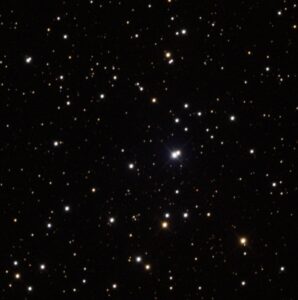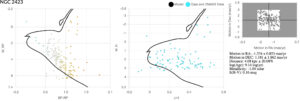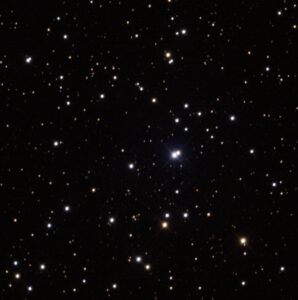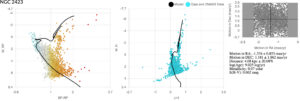NGC 2423 is an intermediate-age, open cluster located in the constellation Puppis. Open clusters contain thousands of stars all formed from the same giant molecular cloud at about the same time.
In an effort to study open clusters and further understand their makeup as part of my FYRE assignment, this star cluster was chosen. Using Skynet’s collection of telescopes I took fifteen images of the star cluster. Five images each were taken using the R, V, and B filters. The R filter passes red light, the V (for visual) filter passes yellow light, and the B filter passes blue light. Using Skynet’s “Afterglow” program I was able to align, stack, and develop a colour image of the star cluster. You can see the image posted below.

NGC 2423 Reddened
Using this photo we can additionally obtain a great amount of data from it. I can take the data photometry from Afterglow and create a graph of all the light sources (stars) identified in the photo to graph them. Using Cluster Pro Plus to graph the data based on an isochrone model to fit it correctly, I can find the star clusters’ motion, distance, age and more. Below are the graph and data listed.
Motion in RA: – 1.374 +/- 0.853 mas/yr
Motion in DEC: 1.181 +/- 1.862 mas/yr
Distance: 4.08 kpc +/- 20.08%
Number of Stars: 798
log(Age): 9.14 log(yr)
Calculated Age: 1.38 billion years
Metallicity: – 1.04 solar
E(B-V): 0.16 mag

Isochrone Model of NGC 2423 – Measured Data
Now, besides just getting to learn all of this interesting data about the star cluster, what can we do with it? Well as you may have noticed the image of the star cluster previously was said to be “reddened” and that is very important to note. As light from those star clusters travels to us here on Earth the light passes through galactic dust. This dust scatters light, with a preference for blue light. So, by the time the light gets to us, it appears redder than it truly is. Now by using the value of “E(B-V)” which is interstellar reddening and interstellar extinction, we can deredden the image of NGC 2423. This image, shown below, was again created through the use of Afterglow.

NGC 2423 Dereddened
Now to compare this analyzed data to studies already completed I will use The Milky Way Star Clusters Catalog, which has data taken from 2012-2015. Plotting this data on an isochrone model can help see if my measured data is any good, or maybe the data from about 10 years ago needs updating. Below you will find the new data, plotted against Gaia’s star system catalogue (more stars than my images).
Motion in RA: – 1.374 +/- 0.853 mas/yr
Motion in DEC: 1.181 +/- 1.862 mas/yr
Distance: 4.08 kpc +/- 20.08%
Number of Stars: 798
log(Age): 9.025 log(yr)
Calculated Age: 1.06 billion years
Metallicity: 0.07 solar
E(B-V): 0.062 mag

Isochrone Model of NGC 2423 – Gaia Data/MWSCC
Looking to compare the two models it’s evident that Gaia has much more data to predict an isochrone model on. However, it does not fit as well. I must note that the MWSCC listed a distance of 0.824 kpc, but this number turned up 0 stars on the model. If that is the true value then some data here must be very off. This leads me to not be able to give a very conclusive answer. I would say my analysis improves the values in the sense that the distance numbers of MWSC that are reported seem to be impossible to display. However, if looking to compare the calculated graphs alone, my analysis lacks plentiful data and may be very off itself.
References
https://in-the-sky.org/data/object.php?id=NGC2423
https://en.wikipedia.org/wiki/Open_cluster#Morphology_and_classification